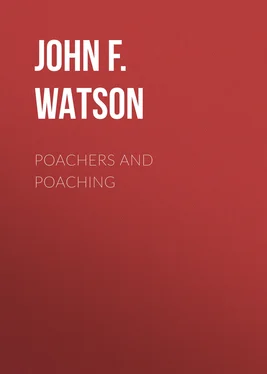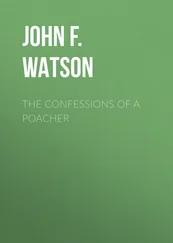John F.L.S. Watson - Poachers and Poaching
Здесь есть возможность читать онлайн «John F.L.S. Watson - Poachers and Poaching» — ознакомительный отрывок электронной книги совершенно бесплатно, а после прочтения отрывка купить полную версию. В некоторых случаях можно слушать аудио, скачать через торрент в формате fb2 и присутствует краткое содержание. Жанр: foreign_prose, Биология, на английском языке. Описание произведения, (предисловие) а так же отзывы посетителей доступны на портале библиотеки ЛибКат.
- Название:Poachers and Poaching
- Автор:
- Жанр:
- Год:неизвестен
- ISBN:нет данных
- Рейтинг книги:3 / 5. Голосов: 1
-
Избранное:Добавить в избранное
- Отзывы:
-
Ваша оценка:
- 60
- 1
- 2
- 3
- 4
- 5
Poachers and Poaching: краткое содержание, описание и аннотация
Предлагаем к чтению аннотацию, описание, краткое содержание или предисловие (зависит от того, что написал сам автор книги «Poachers and Poaching»). Если вы не нашли необходимую информацию о книге — напишите в комментариях, мы постараемся отыскать её.
Poachers and Poaching — читать онлайн ознакомительный отрывок
Ниже представлен текст книги, разбитый по страницам. Система сохранения места последней прочитанной страницы, позволяет с удобством читать онлайн бесплатно книгу «Poachers and Poaching», без необходимости каждый раз заново искать на чём Вы остановились. Поставьте закладку, и сможете в любой момент перейти на страницу, на которой закончили чтение.
Интервал:
Закладка:
CHAPTER IV.
COURIERS OF THE AIR
The power of flight being almost exclusively the characteristic attribute of birds, it is somewhat strange that even the most eminent naturalists should be silent upon it. And yet this is almost universally so. Those who mention the speed of flight do so upon the most insufficient evidence, as witness Michelet's statement that the swallow flies at the rate of eighty leagues an hour. Roughly this gives us a thousand miles in four hours; but assuredly, even in its dashes, the swallow does not attain to anything like this speed. The Duke of Argyll is rather under than over the mark when he computes the speed at more than a hundred miles an hour. Here, however, the mechanism of flight in the swallows is carried through an ascending scale, until in the swift it reaches its highest degree of power both in endurance and facility of evolution. Although there are birds which may, and probably do, attain to a speed of one hundred and fifty miles an hour, this remarkable rate is not to be looked for in any of the birds of the swallow kind. There is something fascinating in the idea of eliminating time and space, and with this attribute popular fancy has in some measure clothed the swallows. At the greater rate of speed indicated above the swallow might, as has been stated, breakfast round the Barbican, and take its mid-day siesta in Algiers. This, however, is a popular myth. In their migrations swallows stick close to land, and never leave it unless compelled; they cross straits at the narrowest part, and are among the most fatiguable of birds. From this it will be seen that although swallows may possess considerable speed, they have no great powers of sustained flight or endurance. These attributes belong, in the most marked degree, to several ocean birds.
Any one who has crossed the Atlantic must have noticed that gulls accompany the ship over the whole distance; or, at least, are never absent throughout the voyage. The snowy "sea swallows," as the terns are called, seem quite tireless on the wing; though the petrels and albatross alone deserve the name of oceanic birds. Sir Edwin Arnold, in an account of his voyage to America, writes as follows of the sea-swallows: "Every day we see playing round the ship and skimming up and down the wave-hollows companies of lovely little terns and sea-swallows, the latter no larger than thrushes. These fearless people of the waste have not by any means followed us from land, living, as gulls often will, on the waste thrown from the vessel. They are vague and casual roamers of the ocean, who spying the great steamship from afar, have sailed close up, to see if we are a rock or an island, and will then skim away on their own free and boundless business. Yonder tiny bird with purple and green plumage, his little breast and neck laced with silver, is distant one thousand miles at this moment from a drop of fresh water, and yet cares no more for the fact than did the Irish squire who 'lived twelve miles from a lemon.' If his wings ever grow weary it is but to settle quietly on the bosom of a great billow and suffer it for a time to rock and roll him amid this hissing spendrift, the milky flying foam, and the broken sea-lace which forms and gleams and disappears again upon the dark slopes. When he pleases, a stroke of the small red foot and a beat of the wonderful wing launch him off from the jagged edge of his billow, and he flits past us at one hundred knots an hour, laughing steam and canvas to scorn, and steering for some nameless crag in Labrador or Fundy, or bound, it may be, homeward for some island or marsh of the far-away Irish coast. Marvellously expressive of power as is our untiring engine, which all day and all night throbs and pants and pulses in noisy rhythm under the deck, what a clumsy affair it is compared to the dainty plumes and delicate muscles which carry that pretty, fearless sea-swallow back to his roost."
No deserts seem to bound the range of the petrels, and they are found at every distance from land. Different species inhabit every ocean—from the fulmar in the far north to the giant petrel which extends its flight to the icebanks of the south. Here the Antarctic and snowy petrels appear, floating upon the drift ice, and never leaving these dreary seas. Another bird of immense wing power is the tiny stormy petrel, the smallest web-footed bird known. It belongs to every sea, and although so seeming frail it breasts the utmost fury of the storm, skimming with incredible velocity the trough of the waves, and gliding rapidly over their snowy crests. Petrels have been observed two thousand miles from nearest land, whilst at half that distance Sir James Ross once saw a couple of penguins quietly paddling in the sea. A pair of the rudimentary wings of this bird are lying before me as I write. These are simply featherless paddles, but by their aid so rapidly does the bird swim that it almost defies many of the fishes to equal it. The enormous appetite of the giant penguin (which weighs about eighty pounds) may have something to do with its restricted powers of flight, and in the stomach of one of these Ross found ten pounds of quartz, granite, and trap fragments, swallowed most likely to promote digestion.
But surely the lord of the winged race is the bird which does not rest; and this may almost be said of the man-of-war or frigate bird. He is a navigator who never reaches his bourne, and from his almost ceaseless flight it would seem as though earth and sea were equally prohibited to him. To a bird with such an immense and superior wing apparatus, the metaphor, "he sleeps upon the storm," becomes almost literal. This black, solitary bird is nearly nothing more than wings, his prodigious pinions measuring fifteen feet, even surpassing those of the condor of the Andes. Although sometimes seen four hundred leagues from land, the frigate bird is said to return every night to its solitary roost.
Of all birds, the albatross has, perhaps, the most extended powers of flight. It has been known to follow a vessel for several successive days without once touching the water except to pick up floating food; and even then it does not rest. In describing the flight of this bird from personal observation, Captain Hutton writes as follows: "The flight of the albatross is truly majestic, as with outstretched motionless wings he sails over the surface of the sea—now rising high in the air, now with a bold sweep and wings inclined at an angle with the horizon, descending until the tip of the lower one all but touches the crests of the waves as he skims over them. I have sometimes watched narrowly one of these birds sailing and wheeling about in all directions for more than an hour without seeing the slightest movement of the wings, and have never witnessed anything to equal the ease and grace of this bird as he sweeps past, often within a few yards—every part of his body perfectly motionless except the head and eye, which turn slowly and seem to take notice of everything. 'Tranquil its spirit seemed and floated slow; even in its very motion there was rest.'" But these birds and the frigate bird are sea and ocean species, and, with rare exceptions, are able to rest upon the waters. This, however, cannot be said of many of the land birds, and here observation is easier.
As an antithesis to the apparently lifeless wings of the albatross, Pettigrew compares the ceaseless activity of those of the humming-bird. In these delicate and exquisitely beautiful birds, the wings, according to Gould, move so rapidly when the bird is poised before an object that it is impossible for the eye to follow each stroke, and a hazy circle of indistinctness on each side the bird is all that is perceptible. When a humming-bird flies in a horizontal direction, it occasionally proceeds with such velocity as altogether to elude observation. Mention of the calm majestic flight of the albatross suggests the possibility of birds resting on the wing. An American naturalist asserts that birds of prey and some others have the power to lock securely together those parts of the wing holding the extended feathers, and corresponding to the fingers of the human hand. The action of the air on the wing in this condition extends the elbow, which is prevented from opening too far by a cartilage, and the wings may keep this position for an indefinite length of time, with no muscular action whatever on the part of the bird. While resting in this way, the bird cannot rise in a still atmosphere; but if there be a horizontal current, it may allow itself to be carried along by it, with a slight tendency downward, and so gain a momentum by which, with a slight change of direction, it may rise to some extent, still without muscular action of the wings. This same naturalist also believes it quite possible for birds to sleep on the wing. As bearing on this subject, Professor J. S. Newbury asserts that he once shot a bird which came slowly to the ground as if still flying, but reached it dead. He believed that it had died high in the air; but had never been able to account for the manner of its descent till now, when he found an explanation in the statement just given.
Читать дальшеИнтервал:
Закладка:
Похожие книги на «Poachers and Poaching»
Представляем Вашему вниманию похожие книги на «Poachers and Poaching» списком для выбора. Мы отобрали схожую по названию и смыслу литературу в надежде предоставить читателям больше вариантов отыскать новые, интересные, ещё непрочитанные произведения.
Обсуждение, отзывы о книге «Poachers and Poaching» и просто собственные мнения читателей. Оставьте ваши комментарии, напишите, что Вы думаете о произведении, его смысле или главных героях. Укажите что конкретно понравилось, а что нет, и почему Вы так считаете.












